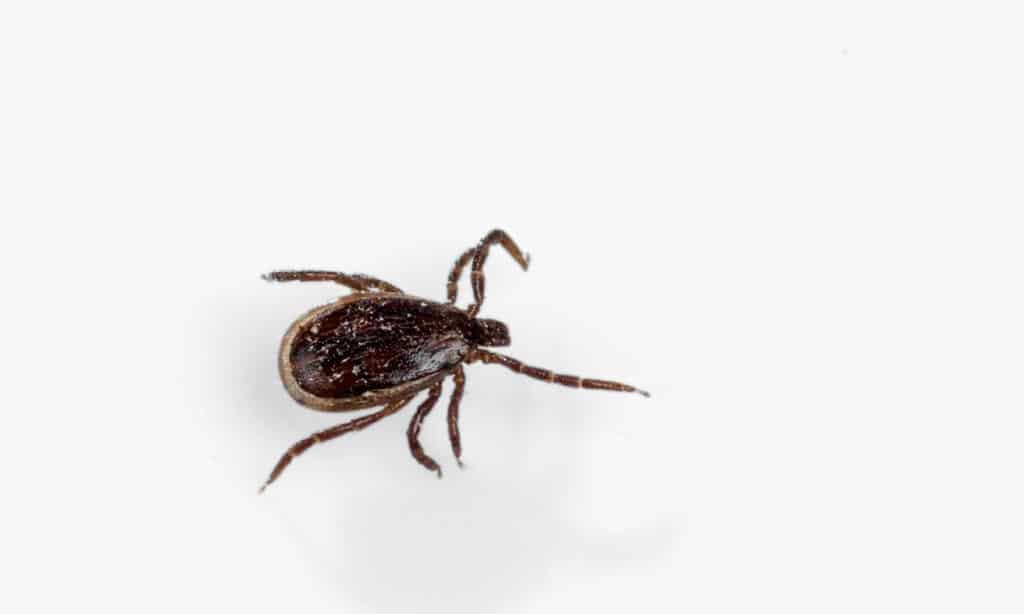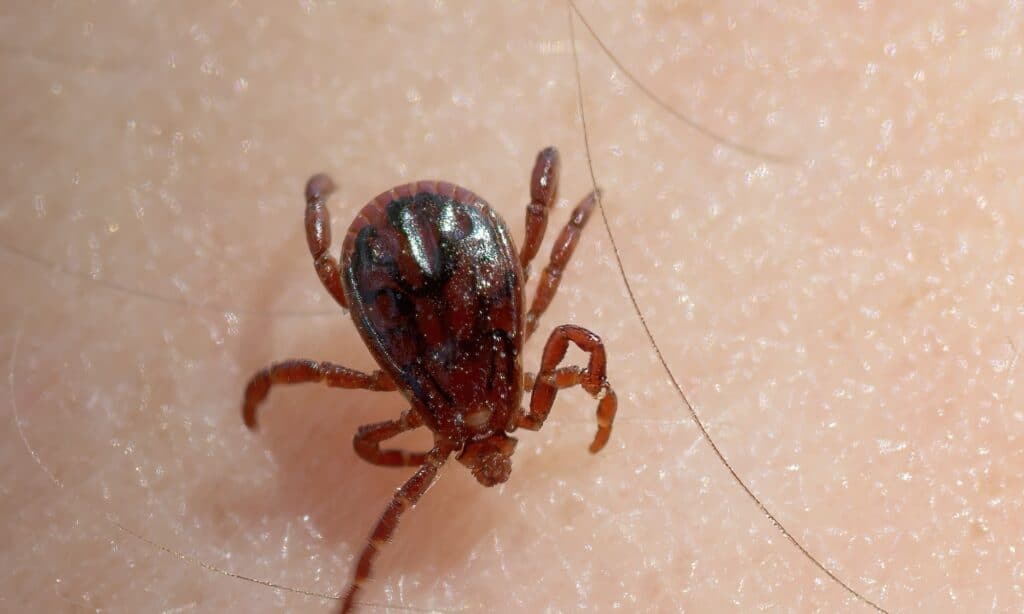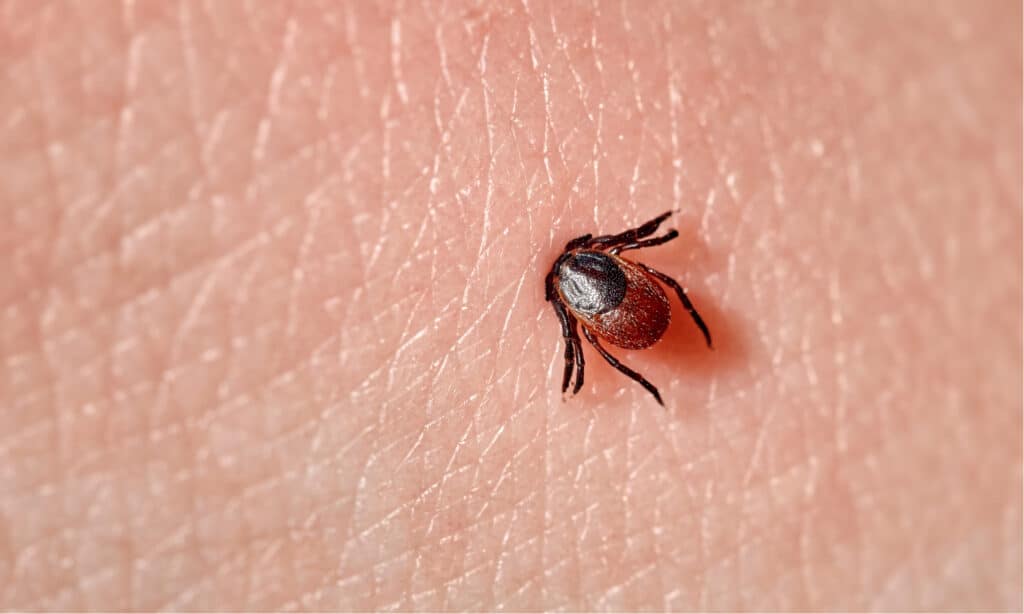Striking fear and disgust into the hearts of many, ticks are an omnipresent fact of life. They live in all fifty states and all seven continents, and one species even lives indoors. Ticks in West Virginia are parasitic arachnids (like spiders, mites, and scorpions) that subsist solely on blood. All ticks have four life stages: egg, larva, nymph, and adult. Most species take a new host for each life stage, though one tick in West Virginia actually sticks to the same host for all three active stages. Tick bodies include mouthparts, abdomens, and legs, each of which serves in identification.
Here, we’ll find out which ticks live in West Virginia and what diseases and infections each species carries. Then, we’ll learn about cases of Lyme disease in the state and how you can prevent ticks from biting you.
American Dog Tick

Dermacentor variabilis, the American dog tick, is one of the most common ticks in the United States.
©iStock.com/nechaev-kon
American dog ticks are the most common ticks in West Virginia. They’re the main vector for Rocky Mountain spotted fever, though this illness is extremely rare in West Virginia. Although they’re also known as wood ticks, American dog ticks live in shrublands and grassy fields. They feed on deer, foxes, skunks, coyotes, dogs, humans, and anything else they can latch onto.
American dog ticks are the largest species of tick in West Virginia. They have brown legs and brown bodies, with small mouthparts. Females have distinct, tan scuta (the hard shields over their upper body) and brown abdomens. Males have mottled tan and brown bodies.
Lone Star Tick

Amblyomma americanum, the lone star tick, lives throughout the wooded areas of West Virginia.
©iStock.com/epantha
Lone star ticks are one of the most common ticks in West Virginia. These ticks live in dense forests and feed on everything from raccoons to domestic horses. They’re the primary vector for human monocytic ehrlichiosis, though they rarely pass it to humans in West Virginia. Lone star ticks are known as aggressive feeders who will even follow carbon dioxide trails to find hosts.
The lone star tick has very large mouthparts that often cause infections at the bite. Females have a single tan dot in the center of their back, while males have some tan mottling. Their mouthparts are very dark, and their legs are brown. These ticks frequent forested areas with plenty of underbrush.
Winter Tick

Dermacentor albipictus, the winter tick, makes its home wherever there are large game animals to feed on.
©iStock.com/VladK213
Winter ticks are small, with mottled brown and tan bodies. Humans rarely see them, and they take only one host for the duration of their life. These ticks are active in the winter and fall, whereas most other ticks in West Virginia are most active in the spring and summer. Winter ticks have been known to severely infest large game animals, like moose, elk, and bear. In fact, there have even been instances of moose with over 100,000 winter ticks embedded in their skin. Winter ticks can actually kill their hosts with these severe infections.
Blacklegged Tick

Ixodes scapularis, the blacklegged tick, is also known as the deer tick.
©iStock.com/Ladislav Kubeš
Blacklegged ticks are one of the most common ticks in West Virginia, particularly in the eastern panhandle. These ticks inhabit forests and edge zones between wooded and open areas. People usually encounter them while camping, hiking, fishing, or hunting. Nymph and larval-aged blacklegged ticks feed on small mammals, like mice, rats, and squirrels. Adults feed primarily on white-tailed deer but won’t say no to a human or dog that strays across their path.
Blacklegged ticks have black legs. Males have small mouthparts and dark brown bodies. Females have large, black mouthparts and black upper bodies. They have red-brown bodies. These are the only ticks in West Virginia capable of spreading Lyme disease, which is the most common tick-borne illness in the state.
Brown Dog Tick

Rhipicephalus sanguineus, the brown dog tick, lives on all seven continents.
©iStock.com/RobertAx
Brown dog ticks aren’t like the other ticks in West Virginia. Where other ticks live outdoors, the brown dog tick lives exclusively indoors. And, they feed almost exclusively on dogs, but may occasionally bite humans. These ticks live in manmade structures in close proximity to dogs. They don’t carry Lyme disease, but they do transmit dog-specific diseases. If you find a brown dog tick embedded in your dog, remove it as soon as possible, and sterilize the bite. Brown dog ticks often crawl on dog beds, dog crates, or even on the walls and ceilings near dogs.
Do Ticks in West Virginia have Lyme Disease?
Blacklegged ticks are the only ticks in West Virginia that carry Lyme disease. These ticks primarily live in the extreme eastern part of the state, though there are recorded cases of Lyme disease in almost every county. To transmit Lyme disease, a blacklegged tick has to be embedded for at least 24 hours. If you suspect that you’ve been bitten by a blacklegged tick, save it upon removal. Then, mail it to a tick testing facility to have it tested for Lyme disease. And, consult your primary care physician.
How to Avoid Ticks in West Virginia

If you’re going camping, hiking, or doing anything else outdoors, remember to take proper tick precautions.
©Evgeniyqw/Shutterstock.com
The easiest way to avoid ticks is by staying out of tall grass and thick brush. Ticks can’t jump, run, or bite through clothing. So, anytime your skin brushes up against foliage, it’s like inviting ticks to dinner. To prevent them from embedding in your skin, wear light-colored clothing that covers as much of your skin as possible. You can also spray your clothes and shoes with permethrin-containing insect repellant.
Finally, after any outdoor activity, be sure to perform a self-check of your entire body for ticks. If you have dogs, check them too.
The photo featured at the top of this post is © Kaldari / Creative Commons – License / Original
Thank you for reading! Have some feedback for us? Contact the AZ Animals editorial team.






